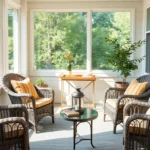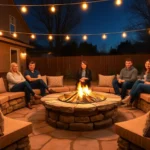We’ve all dreamed of that perfect outdoor dining space where memories are made over delicious meals under the open sky. Whether you’re working with a sprawling backyard or a cozy balcony, creating an inviting outdoor dining area doesn’t have to expensive or require a complete industry overhaul.
From budget-friendly DIY answers to stunning design transformations, we’re about to share the most creative and practical outdoor dining ideas that’ll make your neighbors envious. These aren’t just pretty pictures – they’re real answers that work for real families who want to extend their living space beyond four walls.
Ready to transform your outdoor space into the dining destination you’ve always wanted? We’ve gathered expert tips, clever hacks, and inspiring designs that’ll help you create an outdoor dining area that’s both functional and absolutely gorgeous.
Create a Cozy Patio Dining Space With String Lights and Comfortable Seating
Transforming your outdoor dining area into a cozy retreat starts with the perfect combination of inviting seating and warm lighting. Strategic placement of comfortable furniture paired with ambient string lights creates an intimate atmosphere that rivals any indoor dining room.
Choose Weather-Resistant Furniture for Year-Round Use
Aluminum outdoor dining sets offer the best durability against harsh weather conditions while maintaining their sleek appearance. We recommend powder-coated aluminum pieces that resist rust and fading for 10-15 years with minimal maintenance.
Teak dining furniture provides natural weather resistance and develops a beautiful silver patina over time. Premium teak pieces like those from brands such as Westminster Teak or Kingsley Bate can withstand extreme temperatures from -20°F to 120°F without cracking or warping.
All-weather wicker dining sets combine comfort with longevity when constructed from high-density polyethylene (HDPE) resin. Quality resin wicker furniture maintains its color and flexibility for 8-12 years and requires only occasional cleaning with soap and water.
Stainless steel outdoor tables paired with weather-resistant chairs create a modern dining space that handles coastal salt air and urban pollution. Marine-grade stainless steel (316 grade) offers superior corrosion resistance and can last 20+ years in outdoor environments.
Add Ambient Lighting With Edison Bulb String Lights
Edison bulb string lights create the perfect warm glow for evening outdoor dining with their 2200K-2700K color temperature. We suggest installing 25-foot strands with 2-watt LED Edison bulbs spaced 12 inches apart for optimal coverage over standard dining areas.
Bistro string lights work exceptionally well when hung in zigzag patterns above dining tables at heights between 8-10 feet. Commercial-grade bistro lights with shatterproof bulbs can withstand winds up to 45 mph and operate safely in temperatures from -4°F to 122°F.
Solar-powered string lights offer eco-friendly illumination that charges during the day and provides 6-8 hours of evening light. High-quality solar string lights with polycrystalline solar panels generate enough power for consistent brightness even after partially cloudy days.
Dimmable LED string lights allow you to adjust the ambiance from bright task lighting during meal preparation to soft mood lighting for intimate dinners. Smart string lights compatible with apps like Govee or LIFX offer 16 million color options and scheduling features.
Incorporate Soft Textiles and Outdoor Cushions
Outdoor dining chair cushions made from solution-dyed acrylic fabrics like Sunbrella resist fading and mildew for 5-7 years of regular use. We recommend 3-inch thick cushions with quick-dry foam cores that drain water within 2-3 hours after rain exposure.
Weather-resistant throw pillows in coordinating colors add comfort and style to outdoor dining benches and chairs. Pillows filled with all-weather polyfill maintain their shape and dry 40% faster than traditional cotton-filled alternatives.
Outdoor dining table runners protect surfaces while adding visual interest through patterns and textures. Marine-grade vinyl table runners wipe clean easily and resist staining from food spills and UV exposure for 3-4 seasons.
Patio umbrellas with side curtains provide both shade during daytime dining and privacy for evening gatherings. Cantilever umbrellas with 360-degree rotation and fade-resistant canopies create versatile outdoor dining rooms that adapt to changing sun angles throughout the day.
Design a Rustic Farmhouse Outdoor Dining Area With Natural Materials

Natural materials transform any outdoor space into a warm, inviting farmhouse retreat. We’ll show you how to create this timeless look using authentic elements that blend seamlessly with nature.
Build a DIY Wooden Dining Table and Benches
Building a large wooden table forms the foundation of your rustic farmhouse dining area. Select unfinished or distressed wood surfaces that showcase natural grain patterns and imperfections. Reclaimed barn wood, weathered cedar, or rough-hewn pine create the perfect farmhouse aesthetic while providing durability for outdoor use.
Construct matching wooden benches to complement your table’s rustic charm. These flexible seating options accommodate varying numbers of guests and reinforce the farmhouse style throughout your space. Choose the same wood species as your table to maintain visual consistency.
Treat all wood surfaces with weather-resistant finishes to ensure longevity. Apply marine-grade polyurethane or natural oil-based stains that protect against moisture, UV rays, and temperature fluctuations. This essential step prevents warping, cracking, and premature aging of your handcrafted pieces.
Incorporate weather-resistant fabric runners or simple cotton table coverings for added texture. These soft elements provide protection for your wooden surfaces while introducing subtle color variations that enhance the natural materials.
Use Mason Jar Lighting and Vintage Decor Elements
Install mason jar fixtures filled with string lights or candles to create soft ambient lighting. These iconic farmhouse elements cast a warm glow that enhances evening dining experiences. Position multiple mason jar lights at varying heights to create visual interest and adequate illumination.
Arrange vintage decor accents around your dining area for authentic farmhouse character. Repurposed milk cans serve as unique planters or decorative elements, while wooden crates function as storage answers or plant stands. Antique lanterns and weathered metal signs add historical charm that connects your space to traditional farmhouse aesthetics.
Distribute these vintage elements strategically throughout your dining area for cohesive visual flow. Cluster smaller items like vintage mason jars and old farm tools on side tables or shelving units. Position larger pieces such as milk cans and wooden crates as anchor points that define the space’s boundaries.
Add Potted Herbs and Greenery for Fresh Appeal
Surround your dining table with potted herbs that serve both culinary and decorative purposes. Lavender, basil, rosemary, and mint provide fresh ingredients for cooking while adding vibrant colors and pleasant fragrances to your outdoor space. These practical plants thrive in containers and require minimal maintenance.
Incorporate wildflowers and climbing ivy to soften the overall rustic setting. These natural elements create gentle transitions between your structured dining furniture and the surrounding industry. Choose native wildflower varieties that attract beneficial insects and provide seasonal color changes.
Use simple white dishes and linen napkins to complement your natural wood elements. This understated tableware approach keeps the focus on your beautiful natural materials while maintaining the uncluttered farmhouse aesthetic. Natural fiber napkins and simple ceramic plates enhance the organic feel without competing with your wooden furniture’s natural beauty.
Transform Your Deck Into an Elegant Al Fresco Dining Room

Elevating your deck into a sophisticated outdoor dining destination requires strategic design choices that blend functionality with style. We’ll explore three essential elements that create an upscale al fresco experience right outside your door.
Install a Pergola or Gazebo for Shade and Structure
Pergolas serve as architectural anchors that define your dining space while providing essential overhead coverage. We recommend selecting structures that can support climbing plants like jasmine, wisteria, or grape vines to create natural canopies that enhance aesthetic appeal. Building permits may be required for larger installations, so check local regulations before construction begins.
Gazebos offer more comprehensive shelter with their enclosed roof design, creating intimate dining environments perfect for evening entertaining. Open-air models work best for deck installations since they maintain airflow while protecting guests from unexpected weather changes. Weather-resistant curtains can be added to gazebo structures for optional privacy and enhanced shade control during peak sun hours.
Installation considerations include deck weight capacity, which should be evaluated by a structural engineer for larger pergolas or gazebos. Most composite and hardwood decks can support standard pergola installations, while older or lighter deck materials may require additional reinforcement beams.
Choose Sophisticated Outdoor Dining Furniture Sets
Multi-seating configurations maximize your deck’s entertaining potential by combining chairs, benches, and corner seating options within coordinated furniture sets. We suggest selecting pieces that accommodate 6-8 people comfortably, allowing for intimate family dinners and larger social gatherings throughout the season.
Weather-resistant materials ensure your investment maintains its elegance through multiple seasons without constant maintenance requirements. Powder-coated aluminum frames resist rust and corrosion, while all-weather wicker provides classic styling that complements both modern and traditional deck designs. Teak furniture offers natural weather resistance and develops an attractive silver patina over time.
Design cohesion becomes effortless when you select complete furniture sets rather than mixing individual pieces from different collections. Matching table heights, chair styles, and finish colors create the polished appearance that distinguishes elegant outdoor dining areas from casual patio setups.
Create Privacy With Outdoor Curtains or Screens
Outdoor curtains transform open decks into secluded dining alcoves that feel separate from neighboring properties and street views. We recommend installing curtain rods on pergola beams or gazebo frames to create flexible privacy answers that can be opened or closed based on wind conditions and desired intimacy levels.
Privacy screens offer permanent answers for blocking unwanted sightlines while maintaining natural airflow around your dining area. Bamboo panels, lattice screens, and modern metal designs can be positioned strategically to shield exact angles without creating claustrophobic enclosures that diminish the outdoor dining experience.
Fabric selection plays a crucial role in curtain longevity and appearance, with solution-dyed acrylic fabrics offering superior fade resistance and water repellency compared to standard outdoor textiles. Neutral colors like cream, taupe, and soft gray complement various deck finishes while providing elegant backdrops for seasonal table decorations.
Build a Fire Pit Dining Area for Year-Round Entertainment
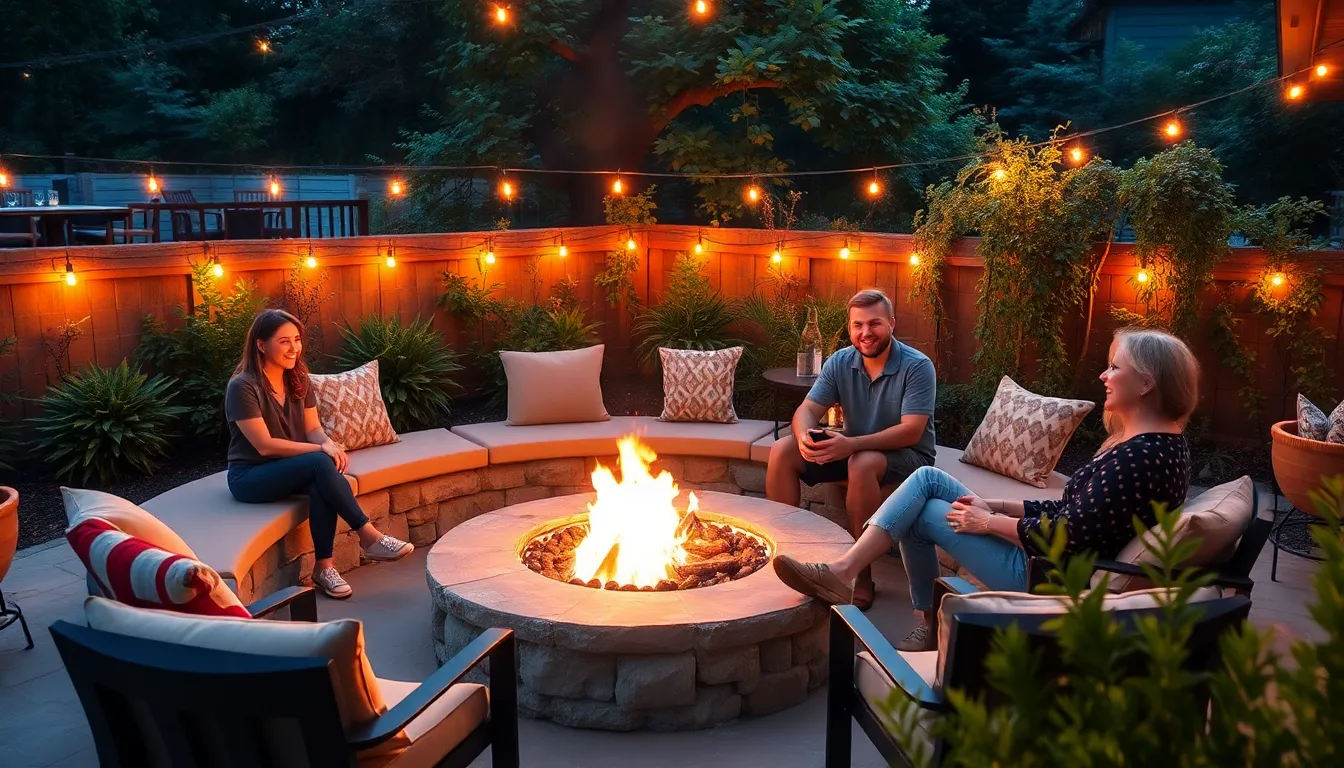
Creating a fire pit dining area transforms our outdoor space into a warm gathering spot that extends entertaining well beyond summer months. We’ll explore how strategic design elements make this setup both functional and inviting.
Position Seating Around a Central Fire Feature
Arranging chairs to face or encircle a centralized fire feature creates the perfect foundation for conversation and warmth. This layout naturally draws everyone together while ensuring each guest receives equal heat distribution from the flames. We recommend spacing seating in a complete circle or horseshoe shape around the fire pit to maximize the social atmosphere.
Consider incorporating multiple seating types to accommodate different preferences and group sizes. Built-in stone benches, individual outdoor chairs, and low backless stools offer varied comfort levels while maintaining the cohesive circular arrangement. Fixed seating elements like stone or concrete benches work particularly well since they won’t shift away from the optimal positioning.
Design the seating height to complement the fire pit’s rim for comfortable conversation across the flames. Standard dining chair height (18 inches) typically works best with fire pits that stand 12 to 15 inches tall. This elevation ensures everyone can see each other clearly while keeping feet comfortably planted on the ground.
Select Heat-Resistant Materials and Safe Spacing
Choose materials that withstand high temperatures without compromising style or safety. Metal furniture with powder coating, natural stone seating, and fire-rated masonry elements resist heat damage while maintaining their appearance over time. These materials also require minimal maintenance compared to wood alternatives in fire-adjacent locations.
Maintain proper distances between the fire pit and all combustible materials according to safety standards. Local fire codes typically require at least two to three feet of clearance from open flames to wooden furniture or overhead structures. We always recommend checking exact municipal regulations since requirements can vary by location.
Avoid placing cushions, umbrellas, or fabric elements too close to the fire source. Even fire-resistant materials can become safety hazards when positioned incorrectly. Store fabric cushions and pillows in designated areas away from the immediate fire zone when flames are active.
Include Built-In Storage for Firewood and Accessories
Incorporate firewood compartments beneath seating to maintain organization while keeping fuel easily accessible. Stone or metal bench designs with hollow centers provide discrete storage that doesn’t interrupt the visual flow of the dining area. These built-in answers keep firewood dry and ready for use without creating clutter around the seating area.
Install weatherproof cabinets adjacent to the dining space for storing grilling tools and fire accessories. These dedicated storage units protect essential items like poker tools, fire-starting materials, and safety equipment from weather damage. Position cabinets within easy reach but outside the immediate fire safety zone.
Design integrated side tables with storage compartments for cushions and entertaining supplies. These multifunctional pieces serve as both surface space for drinks and food while concealing items that need protection from outdoor elements. Choose designs that complement the overall fire pit aesthetic while maximizing storage capacity.
Establish a Garden Dining Oasis Among Your Landscaping

Integrating your outdoor dining space seamlessly into the surrounding industry creates a natural retreat that feels like an extension of your garden. Natural materials like wood and stone help blend seating and dining furniture with complementary planting arrangements for a cohesive design.
Create Pathways Leading to Your Outdoor Dining Space
Designing clear pathways to your outdoor dining area enhances accessibility while guiding guests toward this focal point of your industry. Flagstone, brick, or gravel paths provide both utility and charm, encouraging exploration of your garden before reaching the dining destination.
Stone pathways work particularly well for formal garden settings, offering durability and timeless appeal that complements natural landscaping elements. Brick paths create warmth and texture, especially when laid in herringbone or basket weave patterns that add visual interest to the journey.
Gravel pathways offer an affordable solution that provides excellent drainage while creating a satisfying crunch underfoot. We recommend edging these paths with natural stone or metal strips to maintain clean lines and prevent gravel from spreading into planted areas.
Surround the Area With Flowering Plants and Shrubs
Surrounding your dining space with lush plantings creates privacy while introducing color and texture throughout the seasons. Flowering plants and shrubs ensure a beautiful backdrop that changes with each season, making every meal feel special.
Mid-layer plantings such as grasses, perennials, and groundcovers add tranquility while helping define the edges of your dining zone. These plantings create natural boundaries without blocking views or making the space feel enclosed.
Terraced garden designs incorporating clean stone steps and multi-level plantings add visual interest and enhance privacy around your dining area. Layered plantings at different heights create depth and screening from neighboring properties.
Strategic placement of flowering shrubs like hydrangeas, roses, or ornamental grasses provides seasonal blooms while requiring minimal maintenance. We suggest choosing plants that bloom at different times to ensure continuous color throughout the growing season.
Install Ground-Level or Uplighting for Evening Ambiance
Installing thoughtful lighting extends the usability of your garden dining oasis well into the evening hours. Ground-level lighting and uplighting create ambiance that makes the space inviting after sunset while highlighting your industry’s best features.
Discreet LED path lights guide guests safely along walkways while adding subtle illumination that doesn’t overpower the natural setting. These fixtures work best when positioned every 6 to 8 feet along pathways for consistent lighting coverage.
Uplights highlighting trees or architectural features create dramatic focal points that enhance the dining atmosphere. Position these lights at the base of specimen trees or garden structures to cast beautiful shadows and create visual depth.
Soft overhead lighting from string lights or lanterns provides gentle illumination directly over the dining area without creating harsh shadows on faces. Edison bulb string lights or paper lanterns hung from pergolas or tree branches create the perfect ambiance for intimate dinner conversations.
Set Up a Portable Outdoor Dining Solution for Small Spaces
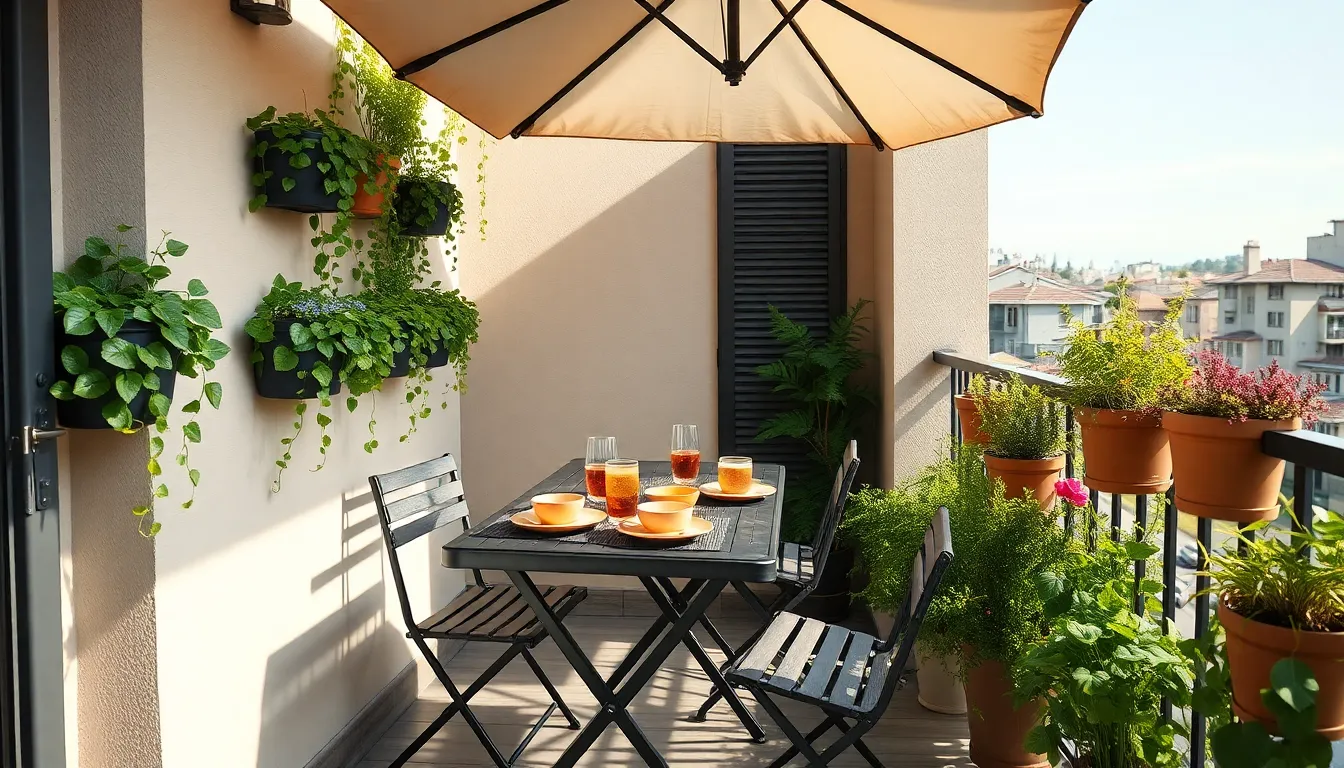
Portable outdoor dining answers transform cramped balconies and tiny patios into functional entertainment areas. Rolling carts serve dishes efficiently while compact tables move wherever you need them most.
Choose Foldable and Stackable Furniture Options
Foldable dining tables collapse flat against walls when you’re not hosting guests. Stackable chairs pile neatly in corners, freeing up precious square footage for daily activities. Weather-resistant materials like powder-coated metal, treated teak, and all-weather rattan withstand seasonal changes without compromising durability.
Bistro sets fold completely for apartment storage, then unfold quickly for impromptu meals. Stackable stools tuck under compact tables or store in weatherproof bins. Multi-functional pieces like ottoman storage boxes provide seating while hiding cushions and table linens.
Use Vertical Space With Wall-Mounted Planters
Wall-mounted planters add greenery without consuming valuable floor space in small dining areas. Trailing plants like ivy and pothos cascade beautifully, softening hard balcony railings and concrete walls. Herb planters positioned within arm’s reach provide fresh basil, mint, and rosemary for outdoor cooking.
Tiered planter systems maximize vertical growing space while creating natural privacy screens. Succulents and air plants thrive in wall-mounted containers with minimal maintenance requirements. Flowering plants in graduated heights add seasonal color without blocking sightlines to scenic views.
Create Shade With Umbrellas or Retractable Awnings
Market umbrellas with tilting mechanisms follow the sun’s path throughout the day, ensuring consistent shade coverage. Retractable awnings extend when needed and retract completely during storms or winter months. Cantilever umbrellas hover over dining areas without center posts interrupting table conversations.
Wall-mounted awnings attach securely to apartment balcony railings or building facades. Pop-up canopies set up quickly for temporary shade during weekend gatherings. UV-protective fabrics in neutral colors complement existing outdoor decor while blocking harmful rays during peak sun hours.
Design a Mediterranean-Inspired Outdoor Dining Retreat

Mediterranean style outdoor dining areas capture the essence of coastal European living with their timeless appeal and natural materials. We’ll transform your space into a warm, inviting retreat that evokes the charm of sun-soaked terraces.
Incorporate Terracotta and Natural Stone Elements
Terracotta tiles create the perfect foundation for your Mediterranean dining space, offering that authentic rustic warmth found in traditional coastal architecture. We recommend installing these tiles on both flooring and accent walls to establish a cohesive design that immediately transports guests to the Italian countryside.
Natural stone elements like limestone or travertine work beautifully for countertops and decorative accents, adding essential depth and texture to your outdoor kitchen area. Limestone’s soft, weathered appearance complements terracotta perfectly, while travertine’s natural pitting creates interesting visual contrast.
Stone planters and low retaining walls built from matching materials help define your dining space while maintaining that authentic Mediterranean aesthetic. Consider using different stone finishes—some polished, others naturally rough—to create visual interest without overwhelming the space.
Add Climbing Vines and Trellis Structures
Climbing vines such as wisteria or grapevines create that essential lush canopy overhead, providing natural shade while adding living texture to your retreat. Wisteria offers stunning purple blooms in spring, while grapevines provide practical fruit harvesting opportunities alongside their decorative appeal.
Wooden trellises support these climbing plants while framing your dining area with architectural structure that feels both purposeful and beautiful. We suggest installing cedar or teak trellises that weather naturally, developing that coveted aged patina over time.
Pergolas offer additional support for heavier climbing plants while creating defined overhead space that feels intimate yet open. Position your pergola to provide afternoon shade during peak dining hours, typically between 2 PM and 6 PM when Mediterranean meals traditionally take place.
Use Warm Color Palettes and Textured Fabrics
Warm color schemes featuring terra cotta, golden yellow, and Mediterranean blue evoke that sun-drenched coastal atmosphere we’re aiming to recreate. These colors work together harmoniously because they’re found naturally in Mediterranean landscapes—from clay pottery to azure seas.
Textured fabrics like linen or canvas for outdoor furniture upholstery add warmth and tactile comfort to your seating areas. Linen’s natural wrinkles and canvas’s sturdy weave both improve with age and weather exposure, developing character that synthetic materials simply can’t match.
Vibrant mosaics and elegant water features enhance the visual appeal while creating soothing ambient sounds that complete your Mediterranean experience. Small mosaic accent tables or decorative wall panels introduce pops of color without overwhelming your carefully curated palette.
Herb gardens positioned nearby enhance the sensory experience with aromatic plants like rosemary, thyme, and oregano that connect directly with Mediterranean cuisine traditions. These practical additions serve double duty as both decorative elements and fresh ingredients for your outdoor cooking adventures.
Create a Modern Minimalist Outdoor Dining Experience
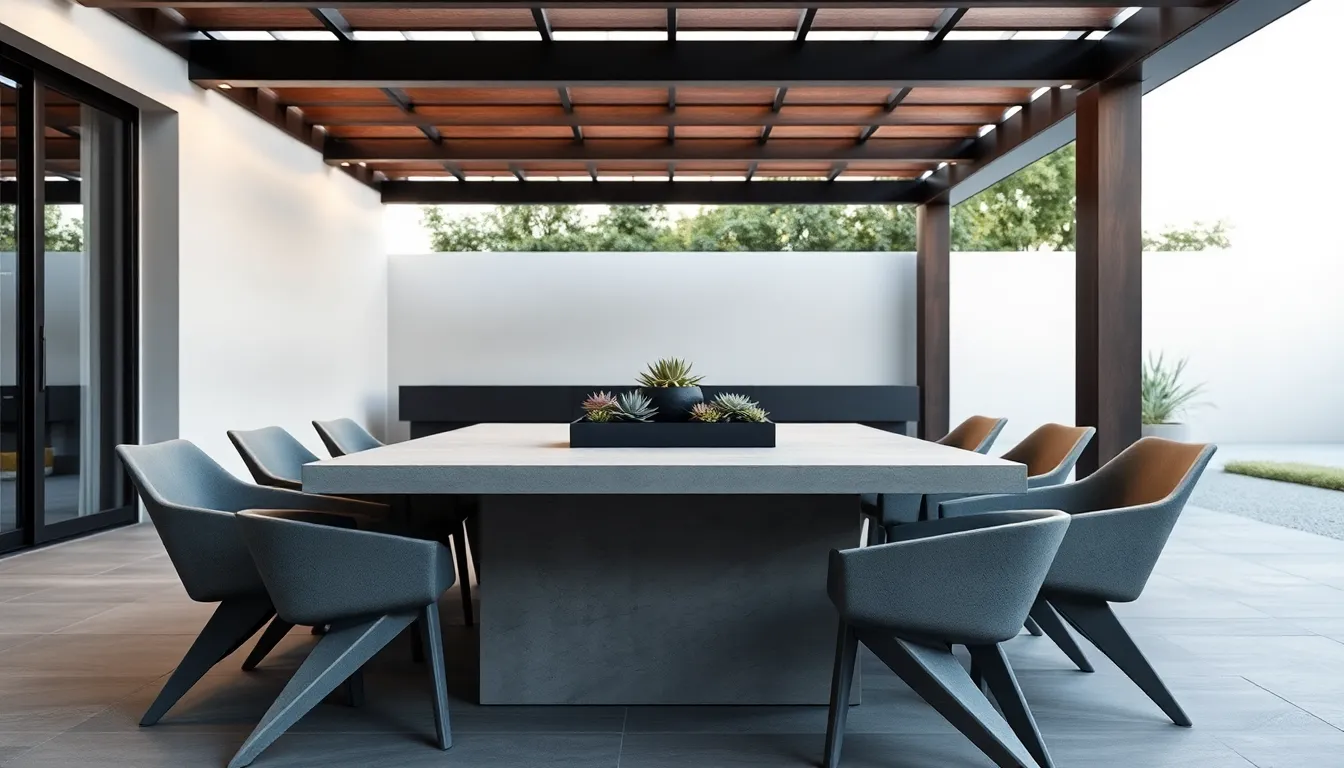
Achieving a modern minimalist outdoor dining space requires deliberate choices that prioritize clean aesthetics and functional design. We’ll focus on creating an uncluttered environment where form meets function seamlessly.
Select Clean-Lined Furniture in Neutral Colors
Choosing furniture with simple geometric shapes forms the foundation of our minimalist outdoor dining design. We recommend selecting rectangular or square tables in materials like concrete or metal, paired with angular chairs that reinforce the minimalist aesthetic. Black, gray, white, and natural wood tones work best for maintaining that clean, contemporary look we’re after.
Arranging pieces with intentional spacing prevents a crowded appearance and allows each element to stand out. Simple geometric forms should dominate our furniture selection, avoiding ornate details or curves that compete for attention. Neutral color palettes create visual cohesion while letting the quality of materials and craftsmanship take center stage.
Focus on Quality Materials Like Teak and Aluminum
Selecting weather-resistant materials ensures both durability and visual appeal in our outdoor dining space. Teak stands out as one of the most recommended options due to its natural weather resistance, sleek appearance, and exceptional longevity. This material offers warmth and natural texture that complements the minimalist aesthetic beautifully.
Aluminum presents another excellent choice for modern outdoor furniture because of its lightweight properties and resistance to the elements. Powder-coated aluminum finishes provide added protection while maintaining that contemporary look we want. Both materials require minimal maintenance while delivering the sophisticated appearance that defines minimalist design.
Keep Decorative Elements Simple and Functional
Maintaining a clutter-free environment means every decorative element must serve a purpose. We suggest using neutral or understated outdoor rugs to define the dining space without overwhelming the clean lines of our furniture. Lightweight curtains or a pergola can provide necessary shade and structure while reinforcing the modern aesthetic.
Built-in LED strips under benches or recessed lighting in pergolas enhance the contemporary feel while providing essential evening ambiance. Minimal accessories work best—think succulents in simple planters or a large serving tray that doubles as decor. Sticking to a monochromatic or restrained color palette allows the form and materials of our furniture to stand out, resulting in that calming, contemporary outdoor dining area we’re creating.
Conclusion
Creating your dream outdoor dining space doesn’t have to be overwhelming or expensive. We’ve explored everything from cozy patio setups and rustic farmhouse retreats to elegant deck transformations and fire pit gathering areas.
Whether you’re working with a sprawling backyard or a compact balcony there’s a solution that fits your space and budget. The key is choosing elements that reflect your personal style while prioritizing comfort and functionality.
Remember that the best outdoor dining areas are those that bring people together. Start with one or two ideas that resonate with you most and build from there. Your outdoor space will evolve into the perfect backdrop for memorable meals and meaningful conversations with family and friends.
Frequently Asked Questions
What’s the most budget-friendly way to create an outdoor dining space?
Start with DIY solutions like building a simple wooden table from reclaimed materials, adding string lights for ambiance, and using weather-resistant cushions. Focus on essential elements first: seating, lighting, and basic weather protection. You can gradually add decorative touches like potted plants and outdoor textiles without breaking the bank.
What type of outdoor furniture lasts the longest?
Weather-resistant materials like powder-coated aluminum, teak, all-weather wicker, and stainless steel offer the best durability. Teak naturally resists moisture and insects, while aluminum won’t rust. All-weather wicker provides comfort and style while withstanding seasonal changes. Always look for UV-resistant finishes to prevent fading and cracking.
How can I create privacy in my outdoor dining area?
Install outdoor curtains or screens around your dining space, use patio umbrellas with side curtains, or create natural barriers with tall potted plants and shrubs. Pergolas with climbing vines, tiered planter systems, and strategically placed trellises also provide privacy while enhancing the aesthetic appeal of your outdoor dining area.
What lighting works best for outdoor dining at night?
String lights with Edison bulbs create warm, intimate ambiance, while bistro lights offer versatile placement options. Solar-powered lights are eco-friendly and low-maintenance. Dimmable LED lights provide customizable brightness levels. Ground-level lighting and uplighting can highlight landscaping features and extend your dining area’s evening usability.
How do I make a small outdoor space work for dining?
Use foldable and stackable furniture that can be stored when not needed. Rolling carts serve as mobile prep stations, while wall-mounted planters add greenery without taking floor space. Compact tables with multiple configurations work well. Market umbrellas or retractable awnings provide shade without permanent installation requirements.
What’s the best way to protect outdoor dining furniture from weather?
Choose materials specifically designed for outdoor use, apply weather-resistant finishes regularly, and use furniture covers during harsh weather. Store cushions and textiles in weatherproof storage when not in use. Position furniture in areas with natural protection from wind and rain, and clean regularly to prevent buildup of debris and moisture.
How can I create year-round outdoor dining opportunities?
Install a fire pit as a central focal point for warmth during cooler months. Use weather-resistant heating elements like patio heaters. Choose furniture and materials that withstand seasonal changes. Add windbreaks and covered areas for protection. Consider enclosed pergolas or gazebos that can be adapted for different weather conditions throughout the year.
What plants work best around outdoor dining areas?
Choose plants that provide privacy, pleasant scents, and visual appeal without attracting pests. Herb gardens like basil, rosemary, and mint offer culinary benefits. Flowering shrubs add seasonal color, while climbing vines on trellises create natural shade. Potted plants offer flexibility and can be rearranged based on seasonal needs and dining requirements.







